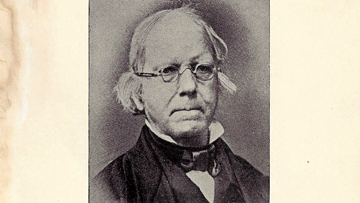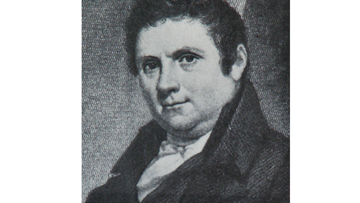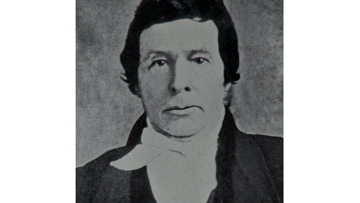The fifth Synod of the Reformed Presbyterian Church of North America met in Philadelphia, Pa., in 1816. Following is some information about this young ecclesiastical body and its meeting.
Where and When?
Synod met in Rev. Samuel B. Wylie’s church in Philadelphia, located on St. Mary Street between Sixth and Seventh Streets. From 1818-1833 the church was located on Eleventh and Marble Streets, and after the denominational divide in 1833 the congregation built the Cherry Street church, for which an engraving exists.
The beginning session was Thursday, May 16, 1816. Synod met daily through the following Thursday, with the exceptions of the 19th (Sabbath) and 21st (no explanation given). Apparently only one session was held each day.
Traveling in 1816
Traveling 200 years ago was time consuming, adventuresome, and often laborious. Delegates would have used means available, including walking, horseback, carriages, and perhaps boat.
Contemporary Affairs
According to the 1810 census, New York’s population was 96,373; Philadelphia’s was 53,722; Baltimore’s was 46,558; and Pittsburgh’s was 4,768.
James Madison was in office as the fourth president. John Marshall was chief justice. Henry Clay was speaker of the house. The American Bible Society was founded on May 11. Indiana entered the Union as the 19th state.
Lodging
Delegates probably stayed with local church members or possibly at rooming houses, but it was not a major problem with only 10 members of Synod. Two were from Utica, Ohio. From the Southern Presbytery were: John Kell (elder) from Beech Woods, Ohio; and John Reilly (minister) from Little Rocky Creek, S.C.
Discussions and Decisions
- A committee was appointed to review the boundaries of presbyteries. Their report, which was adopted, formed four presbyteries from the existing three: Northern – north of New York and east of the Pennsylvania line; Middle – included Pennsylvania, Maryland and Virginia; Southern – south of the northern boundary of North Carolina and Tennessee; and Western – the remaining states and territories.
- A committee was instructed to prepare a draft of a form of church government and to report at the next Synod.
- A newly ordained minister, Mr. Robert Wallace, was introduced and admitted a seat in the court. He had been ordained in 1814 and was installed pastor of the Licking (Utica) and Chillicothe congregations in Ohio.
- A committee was appointed to report at this Synod “to inquire if there be any causes of fasting, and also of thanksgiving.” The committee reported on the last day of Synod that there were indeed causes of fasting and thanksgiving “for the common mercies of life, the increase of churches, the restoration of peace to our country, and the consequent restoration of our correspondence with sister Judicatories abroad.” A resolution was then adopted which resulted in appointing the first Thursday of November to be so observed for thanksgiving.
- Another resolution adopted by Synod stated “The state of the moral world, the prevalence of irreligion in our own country, and the remaining corruptions which retard the progress of personal religion, demand, that attention be given to fasting.” The first Thursday of February was to be so observed for fasting.
- A draft of a suitable covenant was to be given at this Synod, but this was referred to the next Synod.
- Petitions from Ohio and Washington city, craving ministerial aid, were received, and referred to Middle Presbytery.
- Reports were received and approved from Presbyteries.
- The next Synod was scheduled to meet at Coldenham, N.Y., on the first Wednesday of September 1817. Professor Wylie was appointed to open the next Synod with a sermon on evangelical psalmody.
- A committee was appointed to inquire whether ministers have “adequate support, and if not, the best means to remedy the inconvenience.” They reported about their survey, which had three questions: (1) What can a congregation, according to the opinion of its pastor, in existing circumstances, give for the support of the gospel? (2) What can the pastor can comfortably live on? (3) What does the congregation actually give. Synod decided “(1) that this list shall remain on file; (2) That each congregation be required to pay their pastors, according to the respective assessments hereunto annexed, and if there be found a deficit, the minister shall be at liberty to dispose of so much of his time, in whatever manner he shall find convenient, as shall cover the deficit. And this shall be exclusive of the time he shall be obliged to spend in attending Church Judicatories and Presbytery appointments, and (3) That the session of every settled congregation be furnished with an extract of this minute.”
- Several personnel matters were dealt with, but no details are recorded.
- The superintendents of the seminary reported that they had attended to the responsibilities given to them by conducting examinations which resulted in approval of the students. They recommended that presbyteries employ students who are in the third class during vacation. Further, they recommended that Synod take measures for the support of the seminary. This resulted in Synod passing the resolution that each congregation be directed to raise a sum of money annually, which should amount to as much as one dollar for every male member of the congregation. This was to be done by the first day of December. Further, a collection was to be raised for the aid of the seminary on the Sabbath preceding each minister’s leaving home to attend Synod.
- Five hundred dollars were approved for the professor of the seminary.
- A committee was appointed to publish extracts of the minutes for this and previous Synods.
Closing
Synod was concluded on Thursday, May 23, 1816, with prayer by Moderator William Gibson and singing (probably Psalm 133).
Author John M. Mitchell is a volunteer for the RPCNA archives; clerk of session at Rose Point (New Castle, Pa.) RPC; and associate professor emeritus of business administration at Geneva College.


